April 1, 2021 — No one at LEGO told Milan Madge to begin creating a detailed model of the space shuttle.
It was years before the toy company decided to produce the new NASA Space Shuttle Discovery set — released for sale at LEGO Stores and on LEGO.com on Thursday (April 1) — that Madge and some of his fellow LEGO designers began bandying about the idea for a large-scale, toy brick version of the winged orbiter.
"It started more as us just sparring and talking about how cool a LEGO space shuttle in that scale would be, and then it was people saying, 'Oh, what if we used that element for the engines? What if we used this element for the cockpit?' And all those things came together until someone built a concept model," Madge told collectSPACE in an interview.
To be sure, there was a lot of work to be done between the initial idea and the final product. One of the first challenges that Madge took on was how to build in a mechanism to deploy the shuttle's landing gear without impinging on size of the payload bay that needed to hold the set's included model of the Hubble Space Telescope. And that is just one of the many details packed into the almost 2-foot-long (0.5 m) model.
But it was never just a task that Madge and his colleagues were assigned to do; it was a project they wanted to see done right.
"From the very start point, it was just people being passionate for it and having fun making a space shuttle," he said.
collectSPACE spoke with Madge about creating the new LEGO NASA Space Shuttle Discovery set, his favorite parts and any hidden details space shuttle fans should look out for while building the 2,354-piece model. This interview has been edited for length and clarity.
collectSPACE (cS): So you came into this project as fans of the shuttle, but given the level of detail you were able to include, were they any specific references you turned to while designing Discovery?
Milan Madge: Several, actually. The most obvious one is the archive on NASA's website, it's just full of amazing images. So we were just downloading images of the specific mission and shuttle to help inform our design.
But then we also were working really closely with NASA and some of their technical advisors. So we were able to ask really specific questions and they were able to provide really specific feedback, like which logos, for example, were used on certain missions, whether it should be the NASA [logotype] "worm" or the "meatball," and things like that. Also technical details, like what was placed where on STS-31 [the Hubble Space Telescope deploy mission] in comparison to other missions. With the Hubble, there's a certain configuration of the payload bay to get to the telescope to fit in.
There were also technical manuals online that were really fun to look through to find cross sections of the shuttle, the profile of the wings and things like that.
cS: As many know, this is not the first time LEGO has released a space shuttle. There have been more than a dozen sets that have been modeled after the orbiter, at different scales and level of detail. Did you look back at any of those sets for inspiration or to borrow building techniques for the new space shuttle Discovery?
Madge: Not specifically, as in we we didn't look at anything and say, "Let's do it like that." However, having said that, a couple of us that were heavily involved in this project grew up with the Discovery shuttle that LEGO released in 2003. And I remember looking at that set as a kid and being totally blown away by it. I didn't have it, but I remember looking at it in the catalog.
So I think there was some sort of subconscious inspiration there. When we had to pick a mission, we jumped straight for STS-31 because it was what informed our childhood understanding of the space shuttle.
cS: This is the largest space shuttle LEGO has released. Why did you choose the 1/70th scale? What was it about that particular size?
Madge: The thing that really inspired that scale was the Hubble Space Telescope and the STS-31 mission because normally, when we do a space shuttle, the payload bay is kind of, well, I don't want to say an afterthought, but it's often smaller than it should be because of the constraints of working with LEGO bricks.
Being able to go up to that scale meant that we could get the walls of the shuttle thin enough so that we could keep the Hubble in an accurate scale to the orbiter.
We were also able to achieve lots of the fun, little details that we would normally leave out. I think the LEGO Ideas Saturn V rocket that we released a few years ago really set the bar for the level of detail that we could achieve in our space sets and we wanted to continue that with this shuttle. So by going up to that scale, we could include the Canadarm [robotic arm] and the cameras and the crew cabin.
We would normally not include that level of detail on a LEGO model. But by adding those details and being able to explain some of them through the building instructions, we are really taking people on a bit more of a journey. Hopefully when people build it, they'll learn a bit about the shuttle, which they might not have done from a smaller scale model.
cS: Once you settled upon the scale, was there any consideration about including the external tank and solid rocket boosters used to the launch the orbiter as well?
Madge: Yeah, I did build the tank and the SRBs. I did both and it was enormous. So we decided that if were going to go to that scale, if that's what we wanted to do, we needed to really contain the story to the deployment of the Hubble Space Telescope and not go too crazy.
cS: Similarly, at 1/70th, the shuttle is too small to be LEGO minifigure-scale and not quite small enough to be microfigure-scale. This is a model intended for adult LEGO fans, but did you consider including minifigures in the set?
Madge: We know that people really appreciate the minifigure as an icon of the brand and it was discussed about what it would take to go up to a scale that we could fit minigures in it in a realistic way. But the conclusion that we came to was, well... we wanted the scale as we had it and then to keep it as accurate as possible. So we were not making it any smaller to go down to micro-scale, but also if we were to put in any figures, we would lose the storytelling that we have in the crew cabin.
We really liked that we could get the middeck and the flight deck and lots of small details in there that people might recognize from the crew cabin of the real shuttle. So I think that's why we chose to focus on just going as detailed as we could and not distract from that.
cS: What was the biggest challenge from a design standpoint with regards to all of the details you wanted in the final model?
Madge: Definitely the landing gear. We tried loads of different versions with worm gears and ratchets and configurations of springs to make the landing gear work. The really big challenge for me was that we wanted the payload bay to be totally empty so that we could fit to telescope in and adding another plate to either side of the telescope was not enough room for the landing gear to function. So we had to work really hard to get the function coupled to either side of the payload bay.
Essentially, we have this huge hollow area in the middle of the model. And then we have a really heavy nose and a really heavy tail. Somehow we had to make the insides of the payload bay structurally rigid while also containing a function to cuddle the front and real landing gear. From a technical perspective, that was really difficult.
LEGO models internally undergo a lot of testing with robots to run the functions many, many more times than a test subject would have the patience to do so. So we did lots of iterations to find which was the best configuration of the landing gear to make that work while keeping the model strong and keeping the room so we didn't have to scale the Hubble Space Telescope down.
cS: There are a lot of great details packed into this model, like the working landing gear. But were the any you wanted to include and could not, either because of the constraints of the scale or the medium you are working in (LEGO bricks)?
Madge: It may not be the most exciting answer, but the thing that the team was really pushing to include was a toilet in the crew cabin. That's the thing that people really wanted. It's sort of a running joke, but every time we make a LEGO set with a toilet in it, that's the most interesting part to kids. So we really would have liked to include that but the scale of it just wasn't feasible.
I would love to see if someone could modify the shuttle to put that in the model. I'd love to see that as that's the one thing we were missing.
cS: What's your favorite detail of the finished model?
Madge: This goes back to what we were saying about the minifigures. For me, the seats in the crew cabin are my favorite detail.
It's easy to get carried away with how big the vehicles are and how powerful these rockets and shuttles are. But the reason I got interested in space, spaceflight and the cosmos and I'm sure the reason many people do, is the human side of it. None of this stuff would be happening if it wasn't for the human element. So for me, the little blue seats in the crew cabin is a much more emotional tie to the shuttle and that's the thing that I find most exciting, the idea that five human beings left Earth.
In setting up the Hubble Space Telescope, which has obviously informed such a huge amount of our knowledge of the universe, all that happened because of human beings and all that happened for human beings. So for me, those seats in the crew cabin are certainly the most important part of the model.
I really hope that inspires the next generation of astronauts, too. When I was a kid looking at the Discovery model from 2003, that really inspired me to become a LEGO designer. Hopefully, looking at this model, will inspire kids to go into STEM [science, technology, engineering and mathematics], to go into science and maybe even become astronauts, maybe even be the first people to land on Mars. I hope so.
cS: One last question: What about easter eggs? One early review of the NASA Space Shuttle Discovery model assumed you must be a fan of the color olive green, as much of the internal structure of the orbiter is made up of olive green LEGO bricks. But is that a hidden detail?
Madge: You're exactly right, and I think you might be the only person in the world that got that. The inside colors of the model are olive green because the internal structure of the shuttle was green.
cS: So are there any other details like that, which could technically qualify as an easter egg?
Madge: The only other thing that I could say that might be an easter egg is that the part of the Hubble that you have to remove to mount the telescope in the bay is part of the circuitry that they worked with on some of the servicing missions. We didn't just mount the telescope anywhere. We actually included a little hatch that you can remove, which is a neat little detail. |
|
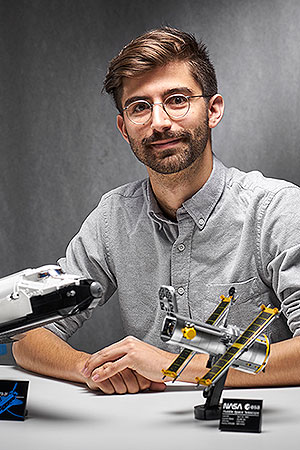
LEGO designer Milan Madge led the creation of the new NASA Space Shuttle Discovery set, as released for sale on April 1, 2021 in LEGO Stores and on LEGO.com. The model is the largest and most detailed space shuttle LEGO has produced to date. (LEGO)
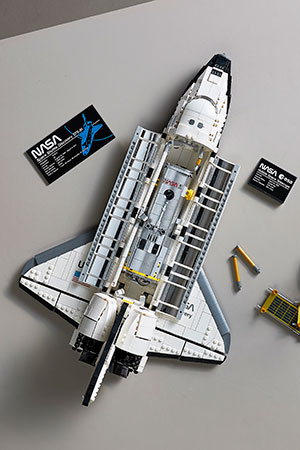
The new LEGO NASA Space Shuttle Discovery set reproduces the winged orbiter and Hubble Space Telescope in detail. (LEGO)
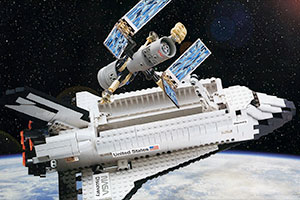
LEGO designer Milan Madge found inspiration for the new NASA Space Shuttle Discovery set from an earlier LEGO set depicting the orbiter and Hubble Space Telescope released in 2003. (LEGO)
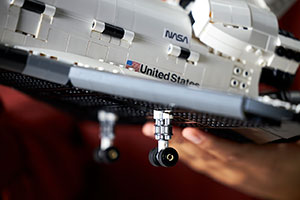
LEGO designer Milan Madge said the most challenging detail to include in the new Space Shuttle Discovery set was how to deploy the landing gear without impinging on the payload bay. (LEGO)
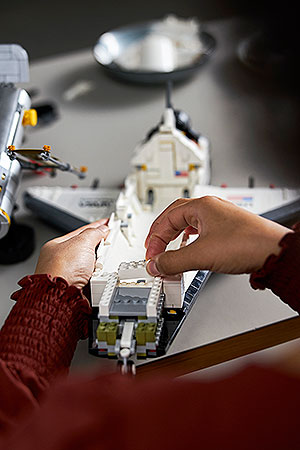
At 1:70 scale, Milan Madge and his fellow LEGO designers had the room needed to include small details in the NASA Space Shuttle Discovery set, such both decks of the crew cabin, cameras in the payload bay and elevons that move opposite each other. (LEGO)
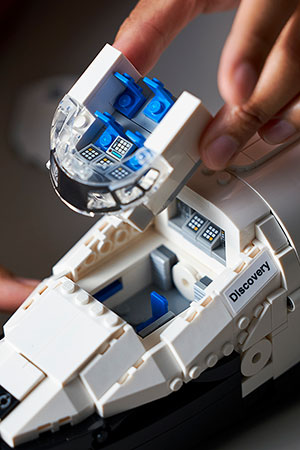
LEGO designer Milan Madge's favorite detail in the new Space Shuttle Discovery set are the five crew seats on the flight and mid-decks of the orbiter's crew cabin. Though not LEGO minifigure-scale, the seats represent the human element of space exploration and evoke an emotional tie to the space shuttle. (LEGO) |
